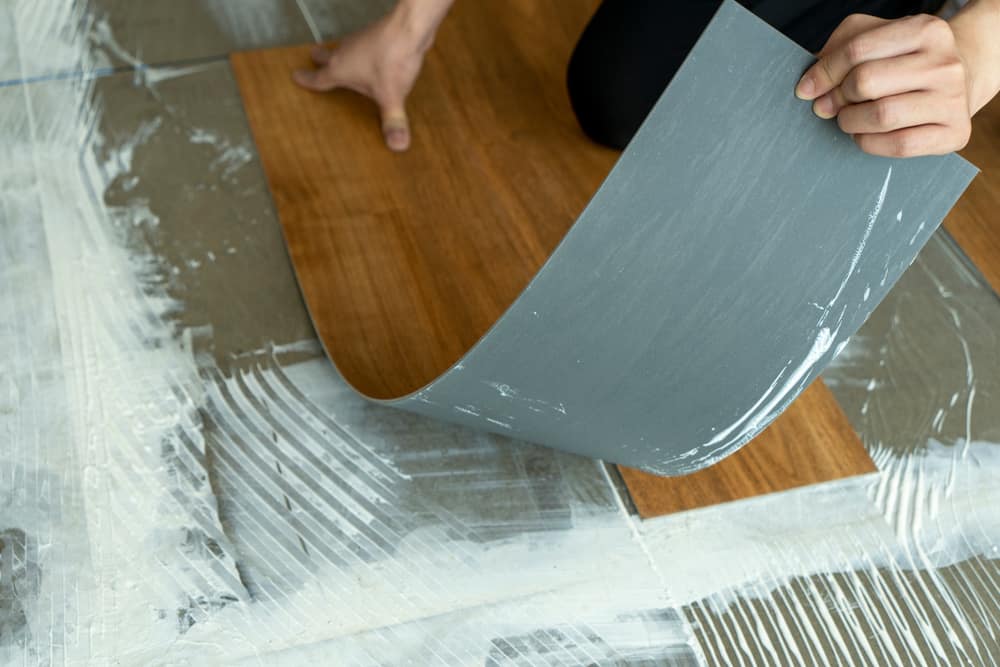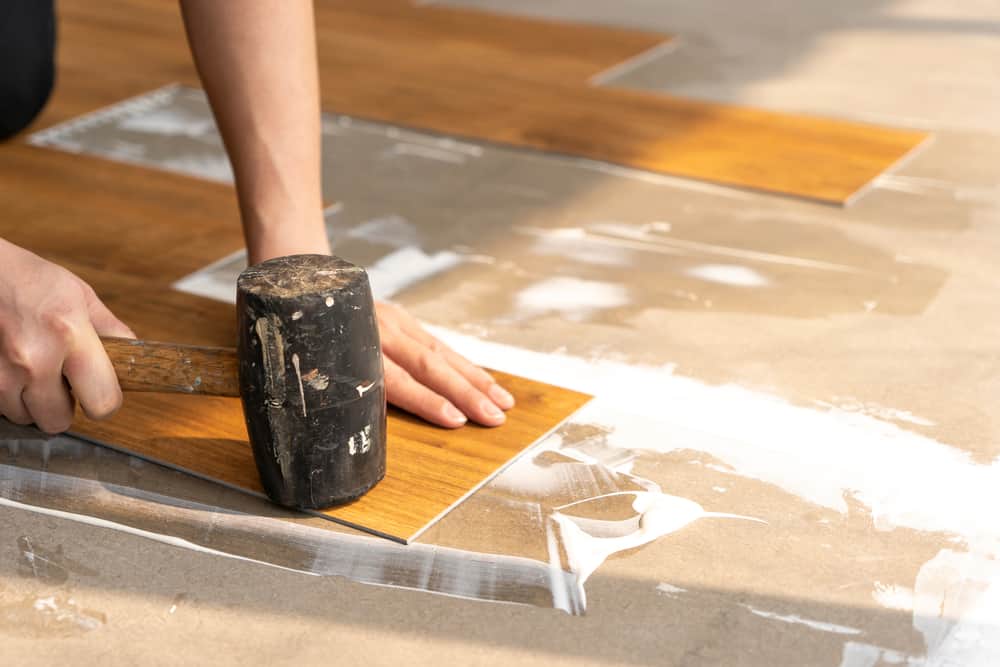So, you have decided to upgrade your old ceramic tiles to vinyl? Well, why not! Vinyl flooring is beautiful, extremely durable, and doesn’t get cold in the winters like ceramic does.
However, like most homeowners, you probably don’t want to pull out the old flooring to install the new one, and this has constantly gotten you wondering, “Can you put vinyl flooring over tile?”
Yes, you can. All you need to do is make sure the ceramic is clean and as smooth as possible. Read on to learn more about laying vinyl flooring over tile.
Table of Contents
The Advantage of Putting Vinyl Flooring Over Tile
During the installation of ceramic tiles, each tile is firmly attached to the ground and because of this, pulling it out can be labor-intensive, not to mention messy and exhausting.
Even if you use power tools to scrape the tiles and grout them away, the process often leaves the surface with bumps and divots, meaning, there is still plenty of manual work that will need to be done to make the surface smooth before installing your vinyl flooring.
In other words, if you decide to remove the tile, you will actually end up doing more work than if you are laying the vinyl over the tile.
Which Type of Vinyl Flooring Should You Put Over Tile?
Installing vinyl flooring over tile is an excellent idea because, by itself, vinyl is so thin, thus it doesn’t provide much insulation. The ceramic subfloor underneath offers extra padding, which makes the floor much comfortable to walk on.
But there is a downside to this, the most common being the increased floor height. However, you will only encounter this problem if you are installing vinyl planks. If you choose sheet or tile flooring, this will be less of an issue because these two raise the level of the floor by a very small amount.
The problem with raised floors is that you may be required to cut your doors shorter, undercut door jambs, or perform other difficult procedures to keep everything working as it should. Sometimes you may also need transition strips at points where the vinyl borders other floors.
Also, keep in mind that the majority of tile floors today have radiant heating to keep the flooring warm during the cold season. If yours has this system set up, you could have limited options on the kind of vinyl flooring you should install in your home.
Vinyl tiles or sheets that need to be glued down, for instance, are not recommended in homes whose floors have radiant heating systems. The high temperatures usually soften the adhesive, reducing the vinyl’s ability to stick well to the subfloor, which causes it to warp or wear prematurely.
For floors with radiant heating, experts recommend installing floating vinyl planks instead, provided the floor temperature stays below 85° F.
Prepare Your Ceramic Floor Adequately Before Installing Vinyl
Before you begin your installation, it is important that you thoroughly prep your subfloor. How much preparation the floor will need will depend on how deep the grout lines are and what type of vinyl floor you are installing.
Vinyl tiles and sheets are so thin that any imperfection in the ceramic tile will be easily visible. Click-lock planks are designed with a rigid or semirigid core, so flaws in the subfloor will not be as noticeable. However, laying the planks on a floor that has large, deep grout lines may cause the intersections to separate.
The half-inch ceramic tiles used in most bathrooms, for example, have very small grout lines and will probably need no prior preparation when laying vinyl plank flooring. However, if you are gluing down vinyl sheets or tiles, you should make sure you have leveled the grout lines first.
Terra cotta tiles and other larger tiles used in patios almost always have deep grout lines. These will need to be covered before installing any type of vinyl floor.
Don’t know how to cover grout lines for vinyl floor installation? Here is a short video that shows you the entire process, including the best materials to use.
Quick Guide for Putting Vinyl Flooring Over Tile
Once you have prepped your ceramic tile, you can proceed to lay the vinyl over it. The installation process will be no different from that of setting the vinyl on a wooden floor, concrete floor, or any other subfloor.
1. Vinyl Plank Flooring
Like all floating floorboards, vinyl planks snap together to create a nice continuous floor. It is best to start your installation from the wall. To get started, place the first plank on the tile such that its tongue joint matches the groove joint of the next tile.
To install the second plank, lift it at an angle and align its tongue to the grove of the first plank. Then lower it to the ground, pushing the joints of both planks together.
Gently tap the planks with a hammer and tapping block to snap them together. Do not use the hammer alone, as it can damage the locking mechanism.
If you need to cut the planks so they can fit properly at wall edges, use a utility knife and straightedge. And to ensure the cuts are as clean as possible, make sure the knife is sharp.
2. Vinyl Tile Flooring
Most people prefer installing vinyl tiles from the center of the room and working their way to the wall. For best results, start by taking the appropriate measurements.
Assuming the room has four walls, you need to measure the distance between each pair of opposite walls and divide it by two to find the center of the room. Use a pencil and a straight line to make a cross in the middle of the floor. This is where your installation will begin.
If you are not laying peel-and-stick tiles, you will need to apply tile mastic to the ceramic subfloor. Do not spread too much or the excess will ooze from the vinyl joints, and you will have to keep stopping your installation to wipe it off.
If you overdo the mastic, the vinyl tiles may also slide. But you can prevent this by placing a piece of board over the tile and kneeling on it instead of kneeling directly on the fresh tiles. Something like plywood will help distribute your weight evenly so it is not concentrated on just a few tiles.
We recommend peel-and-stick vinyl tiles because they are not messy and you can handle them with ease. However, you need to make sure the ceramic subfloor is thoroughly vacuumed before installing these, as any dust or dirt can prevent the adhesive from sticking firmly. Also, if you are going to cut tiles, do so before you peel off the backing paper.
3. Vinyl Sheet Flooring
Some people find vinyl sheets the easiest to put over tile because one sheet can be laid over a large area. Others consider it a harder-to-install option because one silly cutting mistake can damage the whole sheet.
No matter where you stand, installing vinyl sheets is a great way to revamp your old ceramic floor. You can avoid common cutting and installation mistakes by first making a template of the area on which you intend to lay the floor using sheets of kraft paper glued or taped together.
Simply spread the paper over the tile and accurately cut the edges with a blade or knife. Then transfer the resulting shape to the sheet vinyl. Note that you should unroll your vinyl a few hours earlier so it has enough time to flatten.
It is important that you remove the baseboards prior to making the floor’s template and leave a small expansion gap around the edges. And don’t worry about the gap being visible; once you have put the baseboards back in place, they will cover it up.
One thing you need to know about vinyl flooring is that it will expand with changes in humidity and temperature. If your vinyl sheet doesn’t have any room for expansion, it will push against the walls, forming bubbles in the center of the floor.
To install sheet vinyl, simply apply adhesive on the ceramic floor along one of the walls; the adhesive should cover about 1.5 to 2 feet measured from the wall. Next, roll up your vinyl and align it with the wall. Now, start pushing and pressing it into the ceramic.
Once the vinyl has covered all the glued area, spread more adhesive, then unroll the sheet and press it down. Use a floor roller to push the sheet into the adhesive and remove bubbles.
The Takeaway
Putting vinyl flooring over tile is an easy way to refurbish old, dull ceramic tiles. Not only does it require little manual work; the tiles underneath provide extra insulation.
You can install vinyl planks, tiles, or sheets on a ceramic subfloor. But we recommend tiles or sheets because they are thin and do not raise the height of the floor like planks do. Just make sure to fill any tile grout lines and clean the surface before installing your new floor.

